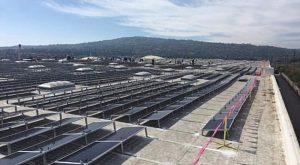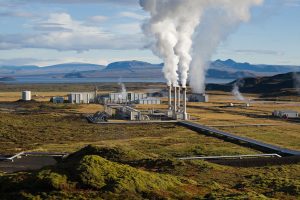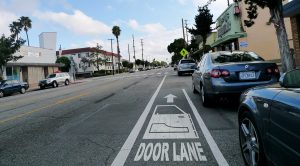Vol. 18 #7 October 29, 2017: Electricity Insurance and the Grid
In This Issue
Flanigan’s Eco-Logic
World’s Largest Rooftop Solar Installation
Net Positive Bhutan and Gross Happiness
Four Countries Lead on Carbon Neutrality
Plans for the World’s Largest Solar Plant
Campus Sustainability
The Dutch Reach
Renewables Rock on Worldwide!
EcoMotion’s Podcast

Flanigan’s Eco-Logic: Electricity Insurance and the Grid
Recently I was asked to speak at a conference of lawyers. My topic is “disruptive technologies in the power sector.” Sounds bad doesn’t it? What good comes out of disruptions? Nasty things like renewable systems and now batteries that threaten utilities’ profits. These, like Uber and AirBNB, are disrupting business as usual for utilities. They are nuisances… and they are not going away.
Disruptive technologies are fueled by innovations and technology advances. Solar systems are now often cost-effective alternatives to buying grid power. If you use a lot of peak power, batteries and other storage systems are starting to pencil. These disrupt the normal way of doing business and in turn offer viable alternatives. Ride the wave!
Perhaps sooner than we expect, we will value and buy electricity insurance. What? Yes, insurance, that in the event that one’s own household electricity system is down, you can buy from the grid. Just like owning a roof in Southern California – that only gets used and proves its worth periodically – you will only call on the grid periodically…when all else fails!
Perhaps someday, central stations, major power transmission and distribution networks will themselves be the “disruptive technologies.” They disrupt views, they threaten beaches and our well-being, and they require major corridors through our forests and parks. In some cases, central systems disrupt our national security. While we have come to accept them, we may well love life better without them. Consider the prize real estate commanded by power plants! Consider the views terribly impacted by transmission lines! Think no more strip mines or offshore oil.
Micro-grids and islanding are the rage today. Some countries, like Tanzania are working to develop micro-grids in remote villages. They make sense given new technologies. They present new ways of looking at power systems by using renewables not as icing on the cake, but instead as base-load production. Micro-grids are in favor, but ideally, I’d argue, that the grid we have today is a fantastic insurance policy. Insurance is well worth its cost. Insurance is about peace of mind and in this case, power when you need it most.
But let’s get real. Utilities will not want to get dimes on the dollar of their current revenue stream. Serving as the back-up insurance underwriter instead of the seller – sounds like a big step down! I suspect it is. So utilities have to get in the distributed generation and storage game. They need to own the means of production, be it household and/or community based. Since innovations and new technologies make distributed energy resources viable, smart utilities will serve this market and secondary insurance markets. Smart utilities – present or future – will own the business!
Quote of the Week:.
World’s Largest Rooftop Solar Installation

Panels as far as the eye can see
The other day I donned hard hat and safety vest and climbed one of the many exterior scaffoldings leading to the roof of 300 Westmont. I am visiting the site of the world’s largest solar installation being built by a small army of technicians. Cranes are lifting pallets of panels, panels being installed a panel a minute, with thousands installed and tens of thousands more to go. All told the installation will be 16.4 MW, nearly 50,000 panels on some 60 acres of roof real estate!
Westmont is a massive distribution warehouse in San Pedro, adjacent to the Port of Los Angeles, and a major oil refinery. Westmont was approached by PermaCity solar to develop the site with solar. Westmont got a brand new TPO roof and will receive lease payments for its property for 20 years. What had once been an unused asset will now generate tens of millions of dollars for Westmont.
For years, EcoMotion has been checking out solar installations: We inspect new systems for two utilities, we represent owners keen on going solar, and we’ve even led international solar research tours to Germany and Spain. Our team has been steeped in solar. But the feelings I had in San Pedro were new to me, almost like solar goose bumps. This is too good to be true!
I drive to the site around lunch hour. This is a busy place; there are tractor trailers everywhere. Then I see the solar works… bright construction vests everywhere, well over 100 workers installing the system. It’s lunch hour. The head of PermaCity Solar, Jon Port, tells me that he is really proud of using veterans to install the systems, arranged through Empower America. The job also uses locally manufactured solar straps, an innovative racking system developed by PermaCity. Bifacial SunPreme panels are used that collect sunlight from above and below. Many of the panels are a whopping 370 watts. And at the end of the day, it’s the largest solar installation in Los Angeles, by a factor of three.
It’s also the largest rooftop solar system in the world! It’s larger than the 11.5 MW, 42-acre system in Punjab, India, the 10 MW Whirlpool Distribution Center in Perris, California, and the 6.4 MW installation at the Mandalay Bay Resort and Convention Center in Las Vegas. Westmont, with 16.6 MW being installed, has some 2 million square foot rooftop for solar. That’s well over 60 acres of land. Westmont gets a new roof and then collects rent payments for the roof for 20 years. The project will generate $76 million in revenue from solar power sold, the power output sold to Los Angeles Department of Water and Power through its Feed In Tariff (FIT) program. The FIT program is an important part of Los Angeles Mayor Garcetti’s goal of 1,500 MW of local solar by 2025.
This site will be featured on EcoMotion’s 2016 Solar Innovation Tour November 15th.
Net Positive Bhutan and Gross Happiness

Don’t worry, be happy
Bhutan is a small nation that lies deep within the Himalayas between China and India, two of the most populated countries in the world. According to recent figures, the country emits around 1.5 million tonnes of carbon annually, while its forests absorb over 6 million tonnes, making it very net positive from a carbon standpoint.
In addition, Bhutan is aiming for zero net greenhouse gas emissions, zero-waste
by 2030, and to grow 100% organic food by 2020. The Himalayan nation is currently 72% forested and its Constitution requires that no less than 60% of it remains forested. It has even banned export logging.
Trees hold special value in Buddhism, the nation’s dominant religion. Last June, a team of 100 volunteers set a world record for planting 49,672 trees in just one hour. Earlier this month, to celebrate the birth of the first child of King Khesar and Queen Jetson, all 82,000 households in Bhutan planted a tree, while volunteers planted another 26,000 in various districts around the country, for a total of 108,000 trees.

Taktsang Monastery, Bhutan
Many have credited its very high Gross National Happiness (GNH) index as part of the reason for the country’s strong commitment to environmental stewardship. The GNH index is like the Gross Domestic Product (GDP) index, GDP relies only on economic indicators and the GNH goes much further. While taking economic measures into account, it also measures prosperity by giving equal importance to non-economic aspects of well-being. The GNH index also surveys knowledge of artisan skills such as embroidery, carpentry and paper making.
Bhutan uses a unique barometer to measure progress. And the message of the declining 2015 Gross National Happiness Index is a troubling one: Bhutan’s new money isn’t buying enough contentment. Bhutan was poor and largely closed to foreigners when its fourth king declared, in the 1970s, that “gross national happiness” was more important than Gross Domestic Product. Tshering Tobgay worried that modern life tends to throw things off-balance. The monarch’s pronouncements about national happiness were only pronouncements until 2010, when Bhutan computed its first happiness index.
So Bhutan’s happiness surveyors think it’s worth asking a few questions:
“How much do you trust your neighbors?”
“Is lying justifiable?”
“Do you feel like a stranger in your family?”
“During the past four weeks, how often have you felt calmness?”
In 2008, then France’s then president, Nicolas Sarkozy, commissioned an influential study of alternative gauges of economic welfare. The U.K. started a “Measuring National Well-Being” program in 2010, and U.S. cities like Santa Monica have followed suit. The U.N. just released its third World Happiness Report, created in response to a 2011 proposal by Bhutan.
For the 2015 Gross National Happiness Index, surveyors from the Centre for Bhutan Studies polled 7,135 citizens on 33 subjects ranging from health and wealth to community vitality and emotional balance. Respondents said they donated less money and devoted less time to volunteer work than in 2010. Fewer planned to vote or attend community meetings. They also reported greater anger, fear and jealousy.
Still, progress elsewhere meant 43.4% of Bhutanese were classified as extensively or deeply happy this year, up from 40.9% in 2010. Fewer people complained of deer, boars and elephants damaging crops. More said they got enough sleep.
Four Countries Lead on Carbon Neutrality
 Four countries are competing to be the first of the world’s 195 nations to go entirely carbon neutral. They are diverse indeed but bonded in carbon neutrality. They made their bold declarations in Monaco at the annual meeting of the Governing Council of the United Nations Environment Program. Iceland, New Zealand, Norway and Costa Rica formally signed up to go zero carbon.
Four countries are competing to be the first of the world’s 195 nations to go entirely carbon neutral. They are diverse indeed but bonded in carbon neutrality. They made their bold declarations in Monaco at the annual meeting of the Governing Council of the United Nations Environment Program. Iceland, New Zealand, Norway and Costa Rica formally signed up to go zero carbon.
These four countries have diverse challenges facing them: Norway’s main issue is emissions from oil and gas. New Zealand’s pollution comes from agriculture. Iceland’s central challenge is transport and industry, notably fishing. Costa Rica faces the special circumstances of being a developing country.
The contenders already get much of their energy from renewables. Iceland has gone the furthest, already achieving almost complete carbon neutrality in heating buildings and in electricity generation. Its greatest asset is disclosed in the name of its capital city, Reykjavik, which means “bay of smokes”, referring to the plumes rising from its hot springs. Such geothermal energy now heats it and much of the rest of the country.

Geothermal Power Station in Iceland
Only 1% of Iceland’s homes are heated by fossil fuels, and 99% of its electricity is generated by geothermal and hydroelectric power. “But we have not entirely kicked our carbon habit”, writes its Environment Minister, Thorunn Sveinbjarnardottir, in the forthcoming issue of UNEP’s magazine, Our Planet.
“Our fishing fleets and our cars are still running on fossil fuels. Our car fleet is one of the biggest, per capita, in the world. The country will give people discounts to buy eco-friendly vehicles and fit fuel cells to fishing boats, aiming to reduce its relatively small national emissions of carbon dioxide by 75% by 2050.
On the other side of the world, New Zealand’s Prime Minister, Helen Clark, has already set her country the goal of being the world’s first carbon-neutral country. It aims to generate 90% of its energy from renewable sources by 2025 and to halve its transport emissions per head by 2040. But the country has a particular problem with agriculture, which accounts for half its emissions of greenhouse gases.
Norway has set an even more ambitious target, aiming for carbon neutrality by 2030, despite being the world’s third largest oil exporter. It already gets 95 % of its electricity from hydroelectric power and heavily taxes cars and fuel: a 4×4 costs four times as much as in the United States. It is planning to capture and store carbon in old North Sea oil fields. But Frederic Hauge – the head of Bellona, the country’s largest environment pressure group – is skeptical. “We are a nice little country of petroholics and that has made us lazy”, he says.
On paper at least, the poorest of the four countries is in the lead – Costa Rica plans to reach its goal by 2021. It has just released a plan of action, which relies heavily on planting trees to soak up emissions. Last year it planted five million of them, a world record, and the banana industry – the country’s largest exporter – has promised to go carbon neutral. Its number of cars, however, has increased more than five-fold in the past 20 years and its air traffic more than seven-fold in just six, making its task far harder.
Plans for the World’s Largest Solar Plant

Source: SolarReserve
A California renewable-energy developer is proposing the world’s largest solar farm in the Nevada desert, a $5 billion project that would rival the capacity of two nuclear power plants. There are still major steps to resolve for the 2 GW Sandstone project.
SolarReserve needs to pick a site, line up financing and find buyers for the power. It will use solar-thermal technology, which is more expensive than standard solar PV power, but also has storage capabilities, so it can send power to the grid all night long.
Instead of converting sunlight directly into electricity with photovoltaic panels, solar-thermal plants use thousands of mirrors to focus sunlight onto towers topped with vats of molten salt. The salt can reach 1,000 degrees Fahrenheit and remain hot for as long as 10 hours, creating steam to power generators. SolarReserve has used the technology for a 110-MW power plant that’s in operation in Nevada, and is planning projects in Chile and South Africa.
The sprawling Nevada project will have 10 towers and cover 15,000 acres. The current biggest solar-thermal plant in the world is the 392 MW Ivanpah facility in California’s Mojave Desert. It has three towers that went into operation in 2014, and doesn’t have storage capabilities.
SolarReserve is eyeing two potential building sites on federal land, both of which will require new transmission lines. The project will be built in stages over seven years and the company is seeking to break ground within three years. SolarReserve plans to market electricity from the project to California utilities, which under state law must source half their power from renewable sources by 2030.
Campus Sustainability
 The 2016 Sustainable Campus Index, a publication by the Association for the Advancement of Sustainability in Higher Education (AASHE), recognizes top-performing colleges and universities overall and in 17 distinct aspects of sustainability, as measured by the Sustainability Tracking, Assessment & Rating System (STARS).
The 2016 Sustainable Campus Index, a publication by the Association for the Advancement of Sustainability in Higher Education (AASHE), recognizes top-performing colleges and universities overall and in 17 distinct aspects of sustainability, as measured by the Sustainability Tracking, Assessment & Rating System (STARS).The Dutch Reach
 Nearly every cyclist has had to quickly swerve out of the way to avoid drivers opening their car doors. My cousin Elizabeth just had a horrific accident in Bethesda, Maryland, sending her into surgery for a broken hip. Opening car doors into bike lanes is dangerous; there’s even a term for it: “dooring.” Getting “doored” recently claimed the life of a young woman from Somerville, Massachusetts.
Nearly every cyclist has had to quickly swerve out of the way to avoid drivers opening their car doors. My cousin Elizabeth just had a horrific accident in Bethesda, Maryland, sending her into surgery for a broken hip. Opening car doors into bike lanes is dangerous; there’s even a term for it: “dooring.” Getting “doored” recently claimed the life of a young woman from Somerville, Massachusetts.
Renewables Rock on Worldwide!

Largest Solar Farm in China, Source: SatCon
Last year, 2015, and for the first time, renewable energy accounted for more than half of new power generation worldwide. New installations of renewable energy overtook conventional power for the first time in 2015, the Paris-based agency said Tuesday in its Medium-Term Renewable Energy Market Report. Global green power rose by a record 153 gigawatts, equivalent to 55 percent of newly installed capacity last year. Total installed renewable capacity exceeded coal for the first time, the IEA said.
Europe is no longer the big driver of green energy growth that it once was. IEA reports that in the next five years, the People’s Republic of China and India alone will account for almost half of global renewable capacity additions. China is expected to build more than twice that global amount in the next five years, driven by its thirst for more electricity capacity, public anxiety over air pollution, and the need to fulfill its climate pledges.
Renewables capacity will be supported by falling costs, according to the agency. Solar panels are projected to be a quarter cheaper over the five year forecast period ending in 2021. Onshore wind-turbine prices may drop 15 percent.
Much of the growth will be driven by four countries, the IEA said, identifying China, the U.S., India, and Mexico as clean-energy hotspots over the next five years. Growth rates in the European Union, an early policy supporter and adopter of clean-energy technologies, may decline.
A few more highlights: Last year, about 500,000 solar panels were installed each day across the globe. China’s rate of renewable energy installation corresponds to two wind turbines every hour. Renewables in India are projected to expand by 76 gigawatts by 2021, led by solar power that is seen growing eight-fold. Mexico’s clean energy capacity is forecast to nearly double by 2021.
 We have a podcast called EcoMotion Conversations!
We have a podcast called EcoMotion Conversations! EcoMotion Conversations give you a chance to listen to the ideas and insights of leading Green Thinkers. We will be asking questions and learning more about how these environmental and sustainability leaders approach and think about their work. We hear enough bad news about our planet and this podcast doesn’t focus on that. These conversations are about the ideas that will lead us to a sustainable future.
